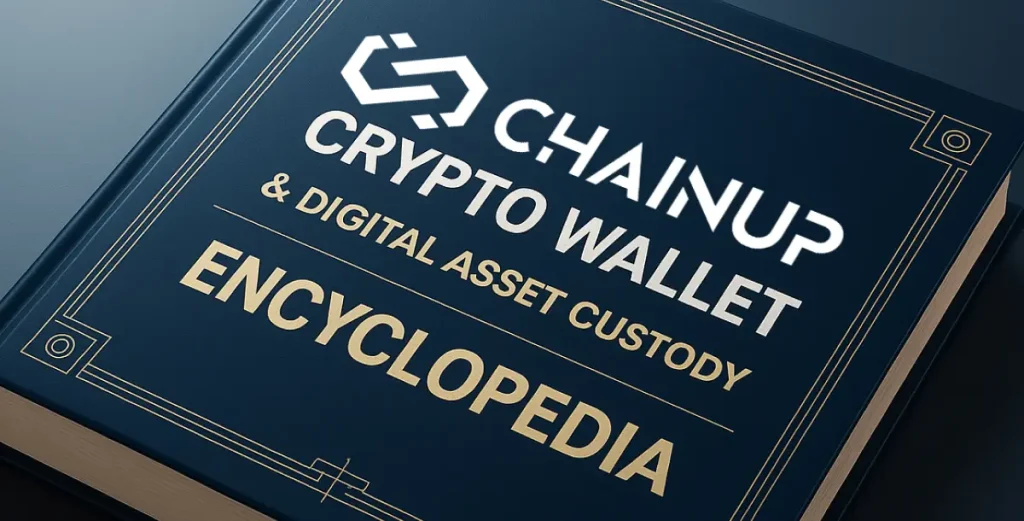The crypto wallet and digital asset custody landscape can be confusing, especially for newcomers. With so many overlapping terms and technologies—such as hot wallets, MPC wallets, custodial vs. non-custodial solutions, and more—it’s easy to lose track of what each really means.
In this encyclopedia-style guide, the ChainUp Academy team aims to provide the most accurate, clear, and concise definitions of key wallet and custody concepts. Whether you’re an individual exploring self-custody or an institution building digital asset infrastructure, this resource will help you understand the core principles that underpin secure crypto storage and management.
Wallet Fundamentals: Key Terms and Definitions
What is a Crypto Wallet?
A crypto wallet is a digital tool that allows users to store, send, and receive cryptocurrencies or digital assets securely. Instead of holding coins physically, a wallet stores the private keys that grant access to the assets recorded on the blockchain.
Crypto wallets come in various forms—software, hardware, or even paper—and can be custodial or non-custodial, depending on who controls the private keys.
What is Crypto Custody?
Crypto custody refers to the secure storage and management of digital assets—including how private keys are generated, stored, and protected against loss, theft, or misuse.
In practice, crypto custody can be:
Custodial, where a regulated custodian or service provider holds and secures assets on behalf of clients (e.g., exchanges, funds, or institutions).
Non-custodial, where individuals or entities self-manage their private keys using wallet infrastructure.
Institutional crypto custody solutions often integrate multi-layer security, MPC (Multi-Party Computation), compliance frameworks, and insurance coverage to meet regulatory and operational requirements.
What is a Custodial Wallet?
A custodial wallet is a wallet where a third-party service provider (also known as the custodian), such as an exchange or a custody platform, holds the private keys on behalf of the user. This means the service provider is responsible for safeguarding the assets and managing wallet security.
Custodial wallets offer convenience—especially for beginners and institutions—since users don’t need to manage private keys directly. However, they require trust in the custodian’s security, compliance, and operational integrity.
In a custodial wallet, the third-party service provider is indeed the custodian.
Here’s how it breaks down conceptually:
Custodian = the entity (usually an exchange, fintech platform, or specialized custody provider) that holds and manages private keys on behalf of users or institutions.
Custodial wallet = the type of wallet arrangement where this custodian controls the private keys.
What is a Non-Custodial Wallet?
A non-custodial wallet gives users full control of their private keys and funds. No third party can access or move the assets without the user’s explicit authorization.
These wallets are often used by individuals and DeFi users who prioritize privacy and self-sovereignty. While non-custodial wallets remove counterparty risk, they also place full responsibility for key management and security on the user.
What is Self-Custody?
Self-custody refers to the practice of personally managing and securing one’s own private keys without relying on intermediaries. It is the foundation of the “not your keys, not your coins” philosophy in crypto.
Self-custody empowers users with full ownership of their digital assets but requires a strong understanding of wallet security, backup methods, and recovery procedures to prevent loss or theft.
The practice “Self-custody” and the tool “non-custodial wallet” are closely related concepts:
Here’s how they connect:
Non-custodial wallet = the tool or technology that enables self-custody.
Self-custody = the action, practice or responsibility of managing your own private keys using that tool.
What is Private Keys?
A private key is a unique cryptographic code that grants access to a user’s digital assets on the blockchain. It acts like a master password that allows the owner to sign transactions and prove ownership of funds.
Every crypto wallet—custodial or non-custodial—relies on private keys for authorization.
If you hold the private keys, you have direct control of your assets (self-custody).
If a custodian holds the keys, they control the assets on your behalf (custodial wallet).
Because anyone with access to a private key can move the associated assets, safeguarding these keys is the foundation of crypto security.
Part 2 - Wallet Types by Security Layer:
The way a crypto wallet connects to the internet determines its security level and accessibility. Wallets are commonly classified as hot, warm, or cold, each balancing convenience and protection differently.
What is Hot Wallet?
A hot wallet is a crypto wallet that is continuously connected to the internet, allowing for quick and easy access to digital assets. These wallets are ideal for frequent trading or payments, as users can send and receive crypto instantly.
However, because they are always online, hot wallets are more vulnerable to cyberattacks, phishing, or malware. Common examples include exchange wallets, mobile wallets, and web-based wallets.
Best suited for: Active traders or platforms requiring instant liquidity.
What is Warm Wallet?
A warm wallet serves as a middle ground between hot and cold wallets. It is connected to the internet only when needed, offering a balance of accessibility and security.
Typically, warm wallets are used by exchanges, payment gateways, and institutional custodians to manage operational liquidity without exposing the entire reserve online.
Best suited for: Businesses or institutions that need frequent transfers but still want stronger protection than a hot wallet provides.
What is Cold Wallet?
A cold wallet is a crypto wallet that remains completely offline, disconnected from the internet at all times. Because it cannot be accessed remotely, it offers the highest level of protection against hacking and unauthorized access.
Cold wallets are often used for long-term storage of large digital asset holdings. Transactions require manual signing and offline authorization before being broadcast to the blockchain.
Best suited for: Long-term investors, institutions, and custodians prioritizing maximum security.
What is a Cold Storage Crypto Wallet?
A cold storage crypto wallet is a specific implementation of a cold wallet, where private keys are stored on offline devices such as USB drives, encrypted disks, or dedicated hardware.
The term “cold storage” is often used interchangeably with “cold wallet,” but it generally emphasizes the method of storing keys offline, rather than the wallet interface itself.
Example: Hardware wallets, air-gapped computers, or paper wallets used for cold storage.
What is Hardware Wallet?
A hardware wallet is a physical device that securely stores private keys offline, protecting them from online attacks. Transactions are signed within the device itself, meaning private keys never leave the hardware environment.
Popular brands include Ledger, Trezor, and SafePal. Hardware wallets combine the security of cold storage with user-friendly interfaces, making them a preferred choice for both retail and institutional investors.
Best suited for: Users who want high security and control without depending on third-party custody.
Part 3 - Advanced Wallet Technologies:
As the digital asset industry matures, new wallet technologies have emerged to improve security, automation, and compliance without sacrificing user control. These include MPC wallets, multisig wallets, smart contract wallets, and Wallet as a Service (WaaS) platforms.
What is MPC Wallet (Multi-Party Computation Wallet)?
An MPC wallet uses Multi-Party Computation (MPC) technology to enhance key security.
Instead of generating a single private key, MPC divides the key into multiple encrypted shares, distributed across different devices or entities.
No single party ever holds the complete key — transactions are signed collaboratively through cryptographic computation.
This design eliminates a single point of failure and enables secure key management, role-based access, and institutional-grade compliance.
Best suited for: Enterprises, custodians, and exchanges that require scalable, secure digital asset management.
White-Label MPC Wallet Solution
A white-label MPC wallet is a customizable, ready-to-deploy wallet infrastructure built using Multi-Party Computation (MPC) technology. It allows businesses—such as exchanges, custodians, and fintech platforms—to launch secure, branded wallet solutions without developing the cryptographic or backend architecture from scratch.
ChainUp’s white-label MPC wallet solution is widely recognized in the crypto and blockchain industry for its robust security, scalability, and compliance readiness.
By combining enterprise-grade MPC technology with flexible integration and multi-chain support, ChainUp enables institutions to offer secure, user-friendly digital asset custody under their own brand with confidence and speed.
What is Multisig Wallet (Multi-Signature Wallet)?
A multisig wallet requires two or more private keys to authorize a transaction. For example, a “2-of-3” multisig wallet means any two of the three key holders must sign to release funds.
Multisig provides shared control and risk mitigation, preventing a single compromised key from granting access to the assets. It’s widely used for joint accounts, institutional custody, or DAO treasury management.
While similar in purpose to MPC, multisig operates at the protocol level, whereas MPC functions at the cryptographic level, offering greater flexibility across blockchains.
Best suited for: Teams, organizations, and custodians managing shared or corporate funds.
What is Smart Contract Wallet?
A smart contract wallet is a blockchain-native wallet powered by programmable smart contracts instead of traditional private keys.
This allows for advanced functionality such as multi-signature authorization, daily spending limits, recovery mechanisms, or integration with DeFi protocols.
Because logic is embedded directly on-chain, smart contract wallets enable automation and customization — ideal for Web3 applications, decentralized identity, and next-gen financial infrastructure.
Best suited for: DeFi projects, Web3 apps, and users seeking programmable security and automation.
What is Wallet as a Service (WaaS)?
Wallet as a Service (WaaS) is a cloud-based infrastructure solution that enables businesses to deploy and manage digital wallets without the need of developing the technology in-house.
Through WaaS APIs, companies can integrate secure wallet creation, key management (often via MPC), and transaction signing directly into their platforms.
WaaS solutions, like ChainUp’s WaaS offering, are designed for exchanges, fintechs, payment providers, and Web3 platforms that require scalable wallet infrastructure with enterprise-grade security, compliance, and operational support.
Best suited for: Businesses and institutions looking to launch or integrate digital asset services quickly and securely.
Part 4 - Institutional Custody Concepts:
Institutional custody has become a cornerstone for compliance, security, and investor protection. Custody is no longer limited to storage — it now encompasses risk management, access control, and regulatory alignment across global jurisdictions.
What is Digital Asset Custody
Digital asset custody refers to the safekeeping and management of cryptocurrencies and tokenized assets on behalf of individuals or institutions.
It involves securing private keys, preventing unauthorized access, and ensuring operational continuity through multi-layer security, encryption, and compliance protocols.
Institutional-grade custody solutions, like those powered by MPC and cold storage architecture, are built to meet the stringent standards of regulated entities, asset managers, and exchanges.
Such solutions also integrate AML/CFT, KYC, and audit trail mechanisms to align with evolving regulatory frameworks.
Best suited for: Exchanges, fund managers, financial institutions, and enterprises seeking regulated, high-security digital asset storage.
What is Trust Wallet (and the Concept of “Trust” in Custody)
In the context of custody, trust refers to the confidence users or institutions place in a custodian’s ability to securely manage and safeguard digital assets.
While “Trust Wallet” is a well-known non-custodial mobile wallet that allows users to manage their own private keys, the broader concept of trust in custody involves transparency, compliance, and proven security standards.
Institutional clients evaluate custodians based on technical integrity, regulatory licensing, and operational resilience, ensuring assets are both safe and compliant with applicable laws.
What is Enterprise Custody Solutions
Enterprise custody solutions are tailored for businesses and institutions managing large or multi-user digital asset portfolios. They typically combine MPC technology, cold storage, and policy-based access control to support multi-authorization workflows, audit logs, and integration with trading, payment, or DeFi systems.
ChainUp’s enterprise custody solution enables institutions to operate with bank-grade security and full compliance, offering configurable roles, automated reconciliation, and 24/7 operational reliability across multiple blockchain networks.
Custody Compliance Frameworks
As regulations evolve, custodians are expected to follow strict compliance frameworks similar to traditional financial institutions. These include adherence to AML/CFT laws, data protection standards, insurance coverage, and third-party audits.
ChainUp’s custody infrastructure is built to meet these requirements—helping clients maintain compliance across multiple jurisdictions while ensuring security, transparency, and operational efficiency.
Compliance Framework in Crypto Wallets
A compliance framework in crypto wallets refers to the set of regulations, policies, and procedures that ensure wallet providers and custodians operate legally and securely.
It typically includes AML (Anti-Money Laundering), KYC (Know Your Customer), CFT (Countering the Financing of Terrorism), data protection, and transaction monitoring measures.
These frameworks help prevent illicit activities, protect users, and align wallet operations with financial and regulatory standards across jurisdictions.
FAQ(s):
Difference Between a Crypto Wallet and Crypto Custody
A crypto wallet is a tool or technology used to store and manage private keys that control access to digital assets.
A crypto custody solution, on the other hand, is a broader framework or service focused on safeguarding those assets—including private key storage, access control, compliance, and risk management.
In simple terms:
- A wallet is what you use to access and manage crypto.
- Custody is how those assets are secured and governed, whether by yourself (self-custody) or by a third-party custodian (custodial custody).




